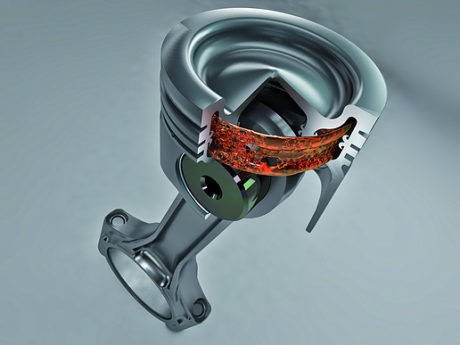Federal-Mogul will show its new Envirokool piston at the IAA Commercial Vehicles Show in Hanover next September. It’s designed to withstand higher temperatures by incorporating a sealed-for-life cooling chamber within the piston crown. The chamber is filled with a specifically formulated cooling oil and an inert gas. The cooling gallery is integrated in the steel piston using friction welding and after charging with the oil and gas is permanently sealed with a welded plug. The inert gas ensures that the coolant will not oxidize.
As a result, the piston crown can withstand temperatures over 100°C (180°F) higher than possible today. By running at higher temperatures, it would ensure that carbon deposits that would normally form in the cooling gallery would be burnt off, which in turn would ensure that heat could be dissipated for the life of the piston.
Heat is transferred from the undercrown through the piston pin, skirt and ring pack and also by using a standard engine oil cooling jet. Since Federal-Mogul claims the Envirokool technology is so effective, the oil cooling flow to the spray jet can be reduced by 50%, which would reduce the workload on the engine oil pump, reducing parasitic losses as well as decoupling the engine oil from cooling, to an extent.
“The technology is mainly applicable to engines with waste heat recovery,” explained Norbert Schneider, Director Global Application Engineering at Federal-Mogul. “Because just making a piston hotter doesn’t save fuel. Right now, the piston is cooled tremendously with lubrication oil. All that heat energy is going into the radiator and is totally wasted. The idea is to increase the temperature of the exhaust gas by cooling the piston much less, but then the piston gets hotter, which is why we need this technology and then with the much hotter gases, a significant proportion of this waste heat can be recovered.”
Up to 5% of energy can be recovered in current waste heat recovery systems and fed back into the drivetrain. “Future legislation will demand a significant reduction in fuel consumption for trucks, engines, and right now this is seen as having a very important potential,” said Schneider.
Learn more: http://articles.sae.org/14911/



